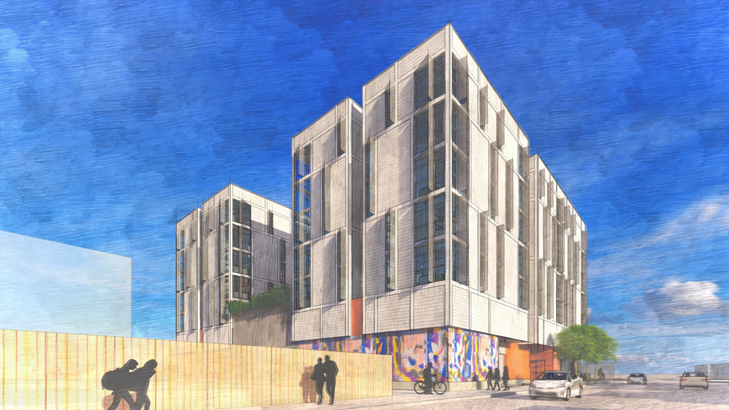San Jose is chipping in $25 million toward an affordable housing project proposed just south of downtown, which officials and advocates said is desperately needed as the city struggles to provide homes for its lower-income residents.
The San Jose City Council on Tuesday unanimously approved loaning $21.35 million to Berkeley-based affordable housing nonprofit Resources for Community Development to construct a 99-unit affordable apartment complex at 797 S. Almaden Ave.
The council also approved spending about $3.6 million to purchase the just over half-acre plot at the corner of South Almaden Avenue and West Virginia Street from the nonprofit, and lease it back to the developer.
The project will reserve 25 apartments as permanent supportive housing for people experiencing chronic homelessness, including 15 apartments for people and their families in need of mental health services, according to city staff reports.
“This is precisely what we need to address our severe housing and homelessness crisis,” David Low, director of public policy for Destination: Home, told the council. Destination: Home is a public-private partnership that works to end homelessness in Santa Clara County.
The development will include 30 studios, 24 one-bedroom, 24 two-bedroom and 20 three-bedroom apartments, plus one two-bedroom manager apartment.

About half of the apartments will be priced as affordable to people earning 30% or less of the annual median income for the area, or about $35,000 per year for an individual. Approximately 40% of apartments will be for people earning up to 50% of the area median income, or roughly $59,000 per year. Nine apartments will be for people earning up to 60% of the median, or roughly $71,000 a year.
The area median income in Santa Clara County for a family of four is about $170,000 annually.
Rachel VanderVeen, assistant director of San Jose’s housing department, said a person earning about $35,000 a year and living in one of the studio apartments in this complex would pay about $880 per month in rent. On the open market, a similar apartment might rent for more than double.
“The market-rate developers are not able to provide apartments with rents at these levels here in San Jose,” VanderVeen said. “If we want to solve homelessness, we have to build housing for extremely low-income households.”
Rising costs
District 3 Councilmember Omar Torres, who represents the Washington-Guadalupe area where the project is proposed, said it’s exactly what the city needs.
“It is literally on a corner where we have seen the worst of the worst that has happened in my community; drive-by shootings, prostitution, drug dealing, and this project is really going to revitalize that little corner,” Torres said. “It’s 50 yards from the house I grew up in for 30 years on Vine and Virginia.”
The project is in the early stages of gathering funding, San Jose officials said. The city’s commitment is a crucial piece for Resources for Community Development to leverage when applying for other major funding sources, including about $26 million from two different state housing grants, $4 million from the county and loans from private equity investors and banks.
The project is estimated to cost about $110 million, or roughly $1.1 million per apartment, including all common areas such as 92 parking spaces, indoor storage and more than 6,000 square feet of open space.
Through its loan and land purchase, the city is supporting the project to the tune of about $250,000 per apartment. The $21.35 million construction loan will be paid back to the city annually with interest over a 55-year lease period, city officials said.
Some councilmembers expressed concern about the rising costs of this project, which shot up more than 30% since its initial application to the city for funding a little more than a year ago.
City staff noted affordable housing projects are facing similar pressures as other developments, with rapidly increasing costs for labor and materials and higher interest rates adding millions to financing costs.
VanderVeen said the city is planning to study how to reduce the costs of affordable housing projects by 15% over the coming three years through modular or prefabricated construction techniques, as well as new financing strategies and the consolidation of applications for funding.
San Jose Mayor Matt Mahan said he’s happy to see the city pursuing ways to bring the high costs of housing down for city-supported affordable projects.
“We’ve got a responsibility to stretch these dollars as far as we possibly can to help the most people we can,” Mahan said.
Contact Joseph Geha at [email protected] or @josephgeha16 on Twitter.
Editor’s Note: Destination: Home CEO Jennifer Loving sits on San José Spotlight’s board of directors.



Leave a Reply
You must be logged in to post a comment.